Brief explanation of temperature data logger
Temperature data loggers are devices used to monitor and record temperature variations over time. They come in various forms, from simple standalone units to more sophisticated real-time monitoring units. Here's how they generally work.
Sensors: Temperature data loggers are equipped with a temperature sensor. The most common types of sensors used are thermocouples, thermistors (which Temprecord mainly use), and resistance temperature detectors (RTDs).
Data storage: The data logger contains a memory component to store the temperature readings. Depending on the logger's memory capacity, it can record thousands of data points. With Temprecord stand-alone loggers, have either 8k, 16k and 32k memory, depending on the type of logger.
Power source: Data loggers can be powered by batteries, which can be replaceable or rechargeable. Some advanced loggers can be powered by external sources or energy harvesting methods. As Temprecord's logger cases are welded closed, it is not possible to replace the batteries (at this stage). However, the usage of long-lasting batteries outweighs the need to have them replaceable.
Calibration: During manufacture, temperature data loggers need to be calibrated to ensure accurate temperature measurements. Calibration involves comparing the logger's readings to a reference thermometer with known accuracy. During recalibration, Temprecord have the calibration corrections built into each logger, which saves time by eliminating the need for a correction formula to be applied to the recorded data and reduces user error.
Sample rate: Users can set the sample rate or recording interval, which determines how often the data logger takes temperature readings. For example, a logger might record temperature every minute, every hour, or at longer intervals, depending on the required application and the duration of monitoring.
Data retrieval: After the monitoring period is complete, the data can be retrieved from the logger. In traditional stand-alone data loggers, this is often done by physically connecting the device to a computer using a cable or a reader interface to download the data using a specialized software. The Temprecord real-time monitoring units offer wireless data transfer, allowing data to be downloaded remotely utilizing Cloud-based software.
Analysis and visualization: Once the data is retrieved, it can be analyzed and visualized using software provided by the data logger manufacturer or compatible third-party software. This enables users to see temperature trends, variations, and any potential issues or anomalies during the monitoring period. Multi-logger validation software (MLV) enables users to compare traces from multiple Temprecord data loggers on one easy to view graph and generate reports with the findings.
Temperature data loggers are used for applications in various fields, including food and pharmaceutical industries (for monitoring storage conditions), environmental studies, HVAC system optimization, transportation of temperature-sensitive goods, and more. They are invaluable tools for ensuring quality control, compliance, and safety in many industries where temperature is a critical factor.

